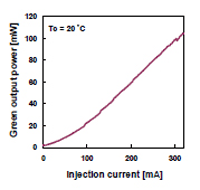- News
20 January 2012
QD Laser exhibits compact prototype 100mW, 532nm green laser module with high efficiency and high-speed modulation capability
 QD Laser Inc of Kawasaki, Japan - together with the University of Tokyo, its Institute for Nano Quantum Information Electronics, and Fujitsu Laboratories Ltd - have developed a high-power 532nm-wavelength compact green laser module with high-efficiency and high-speed modulation capability. A prototype module is being exhibited at the SPIE Photonics West 2012 event (booth 5307) in San Francisco (24-26 January).
QD Laser Inc of Kawasaki, Japan - together with the University of Tokyo, its Institute for Nano Quantum Information Electronics, and Fujitsu Laboratories Ltd - have developed a high-power 532nm-wavelength compact green laser module with high-efficiency and high-speed modulation capability. A prototype module is being exhibited at the SPIE Photonics West 2012 event (booth 5307) in San Francisco (24-26 January).
Figure 1: Prototype module.
High-power green lasers have been attracting attention in many fields, including life sciences and biomedical and industrial applications. Unlike near-infrared lasers for optical communications and red and blue lasers for optical storage, semiconductor lasers provide limited output characteristics at green wavelengths. Therefore, for applications that require high output power at wavelengths around 530nm, diode-pumped solid state (DPSS) lasers are normally used. In these applications, it is imperative to have improved wavelength stability and high-speed modulation capability as well as low power consumption and compact size.
In collaboration with Fujitsu Laboratories and the University of Tokyo (from which QD Laser was spun off in 2006), QD Laser utilized their collective proprietary technologies of semiconductor crystal growth, precise grating fabrication, and device design technology to develop 1064nm high-power single-mode lasers optimized for wavelength conversion (whereby doubling the frequency of the light output halves the wavelength to 532nm). QD Laser markets 1064nm-band DFB (distributed feedback) laser modules, mainly for industrial applications including as a seed source for fiber lasers, and has already shipped them to more than 30 companies worldwide. Furthermore, newly developed module assembly technology enables precise integration of these laser chips with a wavelength-conversion crystal.
A near-infrared high-power single-mode laser (based on proprietary semiconductor DFB laser technology) has therefore been combined with wavelength-conversion technology to yield a compact laser module (of about 0.5cc in volume) that can provide high output power of more than 100mW at a wavelength of 532nm.
 Figure 2: Light output characteristics (DFB current = 100mA).
Figure 2: Light output characteristics (DFB current = 100mA).
According to the test results for the prototype module, 100mW output power under CW (continuous wave) conditions was obtained with power dissipation of about 900mW, representing high wall-plug efficiency of more than 10%. Optical spectral characteristics yielded a narrow linewidth of less than 0.01nm with a high side-mode suppression ratio, which is particularly suitable for precise measurements using optical interference or high resolution spectroscopy.
Tests also confirmed high-speed optical modulation capability of more than 100MHz and a short pulse of less than 1ns operation. This was performed with a simple direct current modulation scheme, which showed that it could be effective for time-resolved spectroscopy and other fields.
It is reckoned that the module shows promise for a wide range of applications such as fluorescence microscopes or spectral analysis in life science or biomedical applications, and precision measurement as well as nondestructive inspection in industry. Furthermore, what is claimed to be unique characteristics of high power, high efficiency, and high-speed modulation with a compact package are also expected to apply to future applications such as head-up displays or ultra-compact mobile projectors in consumer electronics, which are attracting much attention and growing in the market.
QD Laser has already started shipping samples of QLD0593-P05, a module with 5mW output power. In addition, in April it plans to ship samples of the high-power (>50mW) QLD0593-P50 module, for mass production from fourth-quarter 2012.
Development of the green laser module has been supported in part by Japan’s New Energy and Industrial Technology Development Organization (NEDO) and ‘Project for Developing Innovation Systems’ conducted by the Ministry of Education, Culture, Sports, Science and Technology (MEXT).
In addition, in-house epitaxial growth and grating technology provides the flexibility to handle a wide range of wavelength bands, so QD Laser is now extending the wavelength lineup of its DFB laser modules from 1030 to 1300nm. The firm therefore also has the potential to combine them with wavelength-conversion technology to yield visible wavelengths in regions such as 515nm and 555nm for special green laser or 560nm and 590nm for yellow to orange colors. QD Laser says that it will continue with these technical developments to meet market requirements.
www.nanoquine.iis.u-tokyo.ac.jp/index-e.html
